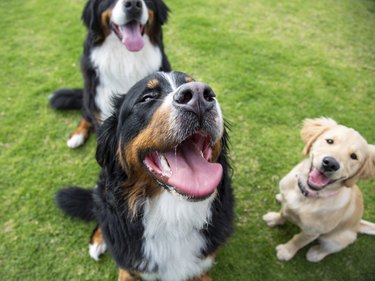Pet parents have likely seen their dog scoot across the carpet. It's a funny sight for many to behold, but there's a medical explanation for those seemingly silly antics: impacted anal glands. Impaction will often cause a dog to scoot or lick their butt frequently, and they will need help to alleviate this issue. While anal gland expression is usually done with the help of a veterinarian, veterinary technician, or groomer, you may be able to clean them at home if you learn how it's done.

Video of the Day
What are anal glands?
Anal glands, or anal sacs, are two small pouches found on either side of a dog's anus. These sacs are lined with sebaceous glands, which produce a foul-smelling fluid that many people describe as smelling "fishy." This liquid lubricates the anus for passing stool, and typically, the sacs will empty during defecation. Dogs may also release their anal glands when they're scared.
Video of the Day
Anal glands are similar to a skunk's scent glands. For a dog, the fluid contains the chemicals used to mark territory. This marking helps other dogs obtain important information long after that dog has left the area, including the age and sex of a dog, whether the dog is ready to mate, or simply whether a certain yard or fence post should be considered off limits to other dogs.

When to express your dog's anal glands
All dogs have anal glands, and usually, these glands function with no issues. But sometimes, they become impacted when the ducts through which the fluid passes get plugged, which may cause the dog's glands to become inflamed. This inflammation is uncomfortable and often causes them to scoot or scratch in an effort to ease the irritation.
If you notice that your dog has secretions from their rear end that have a fishy smell or they keep scooting or licking their hind end, their anal glands should be checked. Expressing your dog's anal sacs alleviates the discomfort of the full glands and prevents the possibility of infections that may lead to abscesses. The best way to learn how to express anal glands is to schedule an appointment so a veterinarian or one of their technicians can demonstrate how it's done. You can also ask your dog's groomer if they are willing to show you.
If your dog has frequent anal gland issues, they could have food allergies. Talk with your veterinarian about a possible diet change and probiotic. Dogs with obesity or bowel movement issues, such as soft stools or constipation, may also need more frequent manual anal gland expression. Small-breed dogs are also more prone to anal sac disease.

Items you need to express a dog's anal glands
Gather the supplies you'll need before you begin in order to keep things as quick and painless for your canine as possible. You will need:
- Paper towels
- A large bowl of soapy water (or you can express your dog's anal glands in the bathtub)
- Lubricant
- Disposable latex gloves (or nitrile gloves if you're allergic to latex)
- Someone to help you
- Optional: a good-smelling, waterless dog shampoo to help reduce the stinky smell

How to clean your dog's anal glands at home
Position your dog
Have your helper stand to the side of your dog, placing one hand under your dog's belly and the other gently under the neck near the face. Be sure the helper has a gentle yet firm posture that will prevent your dog from turning around or moving too much.
Insert your index finger
Put on your gloves. Lubricate your index finger and lift your dog's tail. Gently and slowly insert your finger into the anal opening and stop when you feel your finger slip past the sphincter muscle inside your dog's rectum. If your dog is a particularly small breed, such as a Chihuahua, someone with small hands should express the anal glands.
Find the anal sac
Use your thumb to rub around the outer rim of one side of your dog's anus. Anal glands are located around 4 o'clock on the right side and 8 o'clock on the left side. Lightly run your thumb in that general area until you feel a lump. Anal glands can be as small as a pea, or depending on the size of the dog and how full the glands are, they can be as large as a grape.
If you don't feel anything, it's possible the gland is empty and your dog is scooting for another reason and should be seen by your veterinarian.
Squeeze the glands
Place a paper towel over your dog's anus once the sac has been located. This will prevent the unpleasant experience of getting anal gland fluid on your face or your clothing.
Use your thumb and index finger to gently "milk" the anal gland, which will release the fluid. You shouldn't squeeze too hard or fast to extract an impacted anal gland, although some glands may require a bit of pressure. Sometimes, it helps to milk the gland from back to front or top to bottom, making sure the paper towel is in place the whole time.
If you can't get one or both glands to release or if you're not comfortable squeezing the gland, stop the process and contact your veterinarian. Also, if your dog seems pained when you do this or if you get blood or pus on the paper towel, stop and schedule an appointment. Blood doesn't necessarily mean you injured your dog, but it can mean your pet has an infection.
Clean the area
Use warm, soapy water to gently rinse your dog's bottom. Despite washing, however, you may notice a strong, fishy odor that can linger for a while. Wiping the area with a scented, waterless dog shampoo can help reduce the unpleasantness a little.
The bottom line
Manual expression of a dog's anal sacs is a simple process that dog owners can learn. Ideally, have your veterinarian show you how, especially if your pet has recurring anal gland problems. If you see your dog scooting or licking at their anal area or notice a fishy smell, it probably means they need to have their glands expressed. Redness, excessive swelling, pus, bleeding, or acting pained while anal glands are being checked are signs of anal gland infection, which requires veterinary attention. Small dogs are more prone to anal sac disease, as are dogs with obesity, food allergies, and defecation issues.